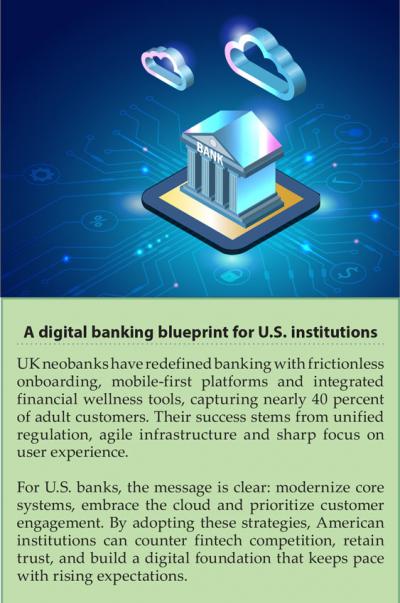The Green Sheet Online Edition
August 25, 2025 • 25:08:02
Digital lessons from across the Pond: Reimagining U.S. banking through the UK model

The UK's digital banking sector today is viewed as a global leader for customer-centric innovation and streamlined digital services. In 2025, nearly 40 percent of UK adults now have a digital-only bank account, nearly triple the figure from just four years earlier (see www.finder.com/uk/banking/digital-banking-statistics). This shift reflects not only the growing trust in digital banking platforms but also the UK's strategic investment in customer experience, open banking and agile financial ecosystems.
For U.S. banks, the road to digital modernization can, at times, appear more intricate. Several factors contribute to this unique landscape, including a multifaceted regulatory environment, the prevalence of legacy infrastructure, and a diverse set of customer expectations shaped by both long-standing traditional banking relationships and the rapid advancements offered by fintech disruptors.
These elements collectively present a distinct set of considerations for American financial institutions. Yet there are valuable insights to be gained from the UK's model, insights that can help American banks refine their offerings, enhance customer engagement and build a more robust digital foundation.
The UK digital banking model
UK neobanks—fully digital banks that operate without physical branches—have seen remarkable growth in a relatively short timeframe. Their share of primary banking relationships has grown from just 1 percent in 2019 to 6 percent in 2025 (see rfi.global/a-tale-of-two-cities-the-rise-and-future-of-neobanks-in-the-uk-and-us/).
This growth reflects how well these digital-first institutions are meeting the evolving needs of mobile and tech-savvy consumers. Features like instant transaction notifications, FX rate locking and real-time spending insights have helped these platforms carve out a distinct advantage, particularly among younger users who expect seamless, app-based financial services (see www.paymentscardsandmobile.com/uk-neobanks-to-outpace-legacy-banks-by-2025/).
The digital-only model not only supports this demand for immediacy and control but also removes many of the frictions associated with legacy banking systems.
Importantly, the UK's relatively unified regulatory framework appears to have accelerated the pace of innovation. With a single regulator overseeing financial services, neobanks and incumbents alike have been able to experiment with open banking APIs, faster payment solutions and enhanced data-sharing models. This coordinated approach has provided a stable environment for bold digital modernization.
U.S. banking challenges and gaps
In contrast, U.S. banks navigate a landscape with multiple regulatory authorities—ranging from the OCC to the CFPB and numerous state-level agencies. This federal and state oversight, while designed to protect consumers and ensure financial stability, can sometimes introduce complexities in standardizing new technologies and digital service delivery across different markets.
Furthermore, legacy infrastructure remains a significant consideration for many U.S. banks. More than 60 percent of U.S. banks identify outdated core systems as a primary barrier to digital modernization (see ibsintelligence.com/ibsi-news/core-banking-crisis-55-of-banks-cite-legacy-systems-as-top-barrier-to-transformation/).
These aging systems, often built on older technologies, can sometimes create silos of customer data, potentially limiting personalization efforts and hindering the seamless delivery of real-time insights. This technological inertia could slow innovation and make it more challenging to adapt to rapidly changing consumer expectations.
As a result of these factors, many U.S. consumers continue to turn to third-party fintech apps to access the kinds of capabilities often readily available through UK digital banks. Only about 55 percent of U.S. banking customers currently cite their bank's mobile app as their primary way of managing finances (see www.aba.com/about-us/press-room/press-releases/consumer-survey-banking-methods-2024 ).
Customer expectations in the United States are also shaped by this dual experience: they expect the traditional trust and security offered by established banks, while simultaneously desiring the agile, feature-rich experiences provided by fintech innovators. This signals both a potential opportunity and a consideration: while banks largely retain trust and regulatory credibility, they might risk ceding aspects of the customer experience to outside platforms if they cannot match the digital agility of their non-bank counterparts.
Key takeaways and potential avenues for U.S. banks
U.S. banks can benefit greatly by exploring the principles that have contributed to the success of UK neobanks, starting with a sharper focus on user-centered design. In the UK, digital-first banks have streamlined customer onboarding processes to take less than five minutes, offering intuitive, frictionless app interfaces that aim to make banking feel as simple as using a messaging app.
This attention to ease of use has led to higher engagement and loyalty, particularly among digital-native users.
Another key opportunity lies in embedding value-added services directly into the banking experience. UK neobanks have prioritized in-app access to P2P payments, budgeting tools and financial wellness features, turning banking apps into full financial hubs. These tools not only increase app stickiness but also deepen customer relationships by addressing broader financial goals, such as saving, debt reduction, and long-term planning.
U.S. banks might also explore how data analytics can deliver meaningful, personalized experiences. UK digital banks have leveraged real-time data to provide customers with spending alerts, savings suggestions and proactive guidance. For American banks, integrating advanced analytics can shift their role from transaction processors to financial partners, strengthening their relevance in an increasingly competitive landscape.
Strategic recommendations
To effectively act on these opportunities, U.S. banks could consider modernizing their technology infrastructure. Moving to cloud-native core systems enables faster product deployment, supports better integration with third-party services and reduces the operational cost of maintaining outdated systems. With greater agility, banks can experiment, adapt and scale innovations far more efficiently.
Banks could also actively explore fintech partnerships—but with a long-term view toward customer experience consistency. While partnering allows institutions to roll out new features quickly, fragmented user experiences can dilute brand trust. The goal should be seamless integration that keeps the customer within a unified digital environment while still benefiting from external innovation.
U.S. banks might even closely monitor global regulatory trends, including those that support open banking and digital identity. By proactively preparing for potential regulatory changes, such as data portability mandates or real-time payment frameworks, banks can position themselves to capitalize on new digital models when the time comes.
The UK's digital banking modernization offers more than a model for technological advancement; it represents a mindset shift toward seamless, secure and highly responsive financial services. U.S. banks, though navigating a more complex operational environment, have clear paths forward.
By prioritizing mobile-first experiences, integrating financial wellness tools and modernizing infrastructure, they can meet rising customer expectations while safeguarding long-term relevance. 
Mark Van Horn is the digital solutions lead in North America for Giesecke+Devrient (G+D). With extensive experience as an entrepreneur in emerging technology and as a leader within G+D's digital team, Mark is a respected thought leader and market strategist within the payment technology industry. His insightful approach to solution initiatives and digital advancements has positively impacted the payment ecosystem as a whole. For more information, please visit .
Notice to readers: These are archived articles. Contact information, links and other details may be out of date. We regret any inconvenience.





